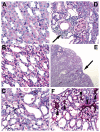A LigA three-domain region protects hamsters from lethal infection by Leptospira interrogans
- PMID: 22180800
- PMCID: PMC3236721
- DOI: 10.1371/journal.pntd.0001422
A LigA three-domain region protects hamsters from lethal infection by Leptospira interrogans
Abstract
The leptospiral LigA protein consists of 13 bacterial immunoglobulin-like (Big) domains and is the only purified recombinant subunit vaccine that has been demonstrated to protect against lethal challenge by a clinical isolate of Leptospira interrogans in the hamster model of leptospirosis. We determined the minimum number and location of LigA domains required for immunoprotection. Immunization with domains 11 and 12 was found to be required but insufficient for protection. Inclusion of a third domain, either 10 or 13, was required for 100% survival after intraperitoneal challenge with Leptospira interrogans serovar Copenhageni strain Fiocruz L1-130. As in previous studies, survivors had renal colonization; here, we quantitated the leptospiral burden by qPCR to be 1.2×10(3) to 8×10(5) copies of leptospiral DNA per microgram of kidney DNA. Although renal histopathology in survivors revealed tubulointerstitial changes indicating an inflammatory response to the infection, blood chemistry analysis indicated that renal function was normal. These studies define the Big domains of LigA that account for its vaccine efficacy and highlight the need for additional strategies to achieve sterilizing immunity to protect the mammalian host from leptospiral infection and its consequences.
Conflict of interest statement
The authors have read the journal's policy and have the following conflicts: Authors D.A.H. and J.M. are coinventors on United States Patent 7935357.
Figures






References
-
- Levett PN. Leptospirosis. In: Emmerson A, Hawkey P, Gillespie S, editors. Principles and Practice of Clinical Bacteriology. Edinburgh; 1997. pp. 677–690.
-
- Hartskeerl RA, Collares-Pereira M, Ellis WA. Emergence, control and re-emerging leptospirosis: dynamics of infection in the changing world. Clin Microbiol Infect. 2011;17:494–501. - PubMed
-
- WHO . Geneva, Switzerland: WHO; 2003. Human leptospirosis: Guidance for diagnosis, surveillance and control.
Publication types
MeSH terms
Substances
Grants and funding
LinkOut - more resources
Full Text Sources
Research Materials

